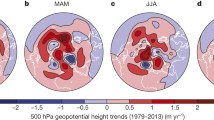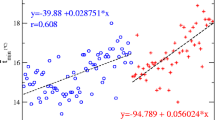Abstract
The configuration of the northern hemispheric general atmospheric circulation system shifted from a zonal to a meridional pattern in the early 1950s. Winter climatic regions in the conterminous United States are developed for a ten year period dominated by zonal flow and a second decade of meridional flow using a combination of principal components factor analysis and a Euclidean distance clustering algorithm. The results demonstrate that regional patterns in the surface climatic data substantially changed as the circulation system shifted its basic configuration. The regional structures of the eastern United States and the Great Plains appeared to be particularly sensitive to the change in the upperlevel flow pattern.
Similar content being viewed by others
References and notes
Oliver, J. E.: 1973, Climate and Man's Environment, John Wiley, New York, pp. 169–191.
Critchfield, H. J.: 1960, General Climatology, Prentice-Hall, Englewood Cliffs, N.J., p. 165.
Russell, R. J.: 1932, Univ. of California Publs. in Geogr. 5.
Russell, R. J.: 1934, Geogr. Rev. 24, 92.
Bowman, I.: 1935, Geogr. Rev. 25, 43.
Kendall, H. M.: 1935, Geogr. Rev. 25, 117.
Kendall [6] stated that the idea of ‘climatic years’ was first suggested to him in 1928 by the noted geographer Preston E. James.
Gregory, S.: 1954,Erdkunde 8, 246.
Dayal, E.: 1962, Indian Geogr. J. 37, 83.
Doerr, A. H. and Sutherland, S. M. 1964, J. Geogr. 63, 62.
Bryson, R. A., Baerreis, D. A., and Wendland, W. M.: 1970, in W. Dort Jr. (ed.), Pleistocene and Recent Environments of the Central Great Plains, The University Press of Kansas, Lawrence.
Borchert, J. R.: 1950, Ann. Assoc. Am. Geogr. 40, 1.
Borchert, J. R.: 1961, Ann. Assoc. Am. Geogr. 61, 1.
Lamb, H. H.: 1966, The Changing Climate, Methuen, London.
Lamb, H. H.: 1977, Climate: Present, Past and Future. Vol. 2. Climatic History and the Future, Methuen, London.
Bryson, R. A.: 1966, Geogr. Bull. 8, 234.
Krebes, J. S., and Barry, R. G.: 1970, Geogr. Rev. 60, 548.
Sorenson, C. J.: 1977, Ann. Assoc. Am. Geogr. 67, 214.
van Loon, H. and Williams, J.: 1976, Monthly Weather Rev. 104, 365.
Kalnicky, R. A.: 1974, Ann. Assoc. Am. Geogr. 64, 100.
Dzerdzeevskii, B. L.: 1966, in H. E. Wright (ed.) Quaternary Geology and Climate, National Academy of Sciences, Washington.
Harman, J. R.: 1971, Tropospheric Waves, Jet Streams, and United States Weather Patterns, Commission on College Geography Resource Paper No. 11 (Assoc. Am. Geogr., Washington).
U.S. Department of Commerce, NOAA, Climatological Data: National Summary, National Climatic Center, Asheville, N.C.
Mitchell, J. M., Dzerdzeevskii, B., Flohn, H., Hofmeyr, W. L., Lamb, H. H., Rao, K. N., and Wallen, C. C.: 1966, Climatic Change, Technical Note No. 79, W.M.O., Geneva.
Clark, P. J. and Evans, F. C.: 1954, Ecology 35, 445.
A nearest-neighbor statistic, R, of 1.36 determined for the station network falls along a continuum between the random (R = 1.00) and uniform (R = 2.15) patterns.
Berry, B. J. L. and Ray, D. M.: 1966, in T. Rymes and S. Ostry (eds.), Regional Statistical Studies, University of Toronto Press, Toronto.
Steiner, D.: 1965, Tijdschr. Kon. Ned. Aardr. Gen. 82, 329.
McBoyle, G. R.: 1971, Austral. Geogr. Stud. 9, 1.
Sneath, P. H. A. and Sokal, R. R.: 1973, Numerical Taxonomy, Freeman, San Francisco.
Amedeo, D. and Golledge, R. G.: 1975, An Introduction to Scientific Reasoning in Geography, Wiley, New York.
Sneath and Sokal [30] describe a cophenetic correlation statistic that estimates the effectiveness of a linkage tree in displaying relative-distances in climatic space. It is the correlation of implied climatic distances between stations on the linkage tree and actual distances between stations in climatic space. The high cophenetic correlation values (0.93 and 0.88 for the zonal and meridional periods, respectively) calculated in the study suggest that meaningful clustering was accomplished.
Mitchell, J. M.: 1953, J. Met. 10, 244.
Chorley, R. J., and Haggett, P.: 1968, in B. J. L. Berry and D. F. Marble (eds.), Spatial Analysis, Prentice-Hall, Englewood Cliffs. N.J.
Callendar, G. S.: 1961, Quart. J. Roy. Met. Soc. 87, 1.
Mitchell, J. M.: 1963, in Changes of Climate, Arid Zone Research XX, UNESCO, Paris.
Manley, G.: 1974, Quart. J. Roy. Met. Soc. 100, 387.
Brinkmann, W. A. R.: 1976, Quat. Res. 6, 355.
Wendland, W. M. and Bryson, R. A.: 1981, Monthly Weather Rev. 109, 255.
Author information
Authors and Affiliations
Rights and permissions
About this article
Cite this article
Balling, R.C., Lawson, M.P. Twentieth century changes in winter climatic regions. Climatic Change 4, 57–69 (1982). https://doi.org/10.1007/BF00143192
Received:
Revised:
Issue Date:
DOI: https://doi.org/10.1007/BF00143192




